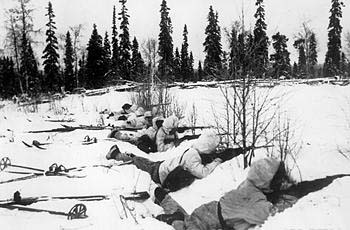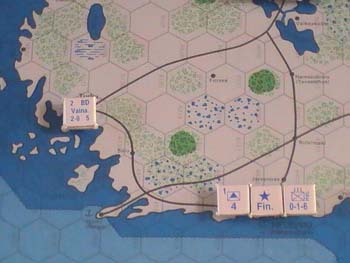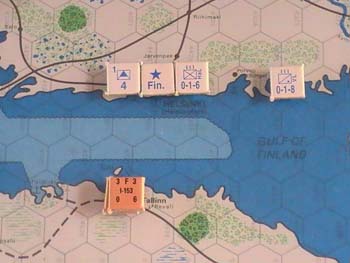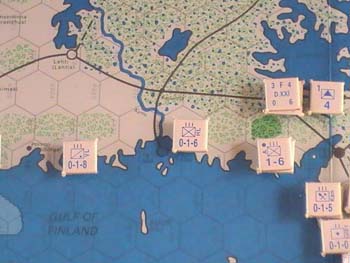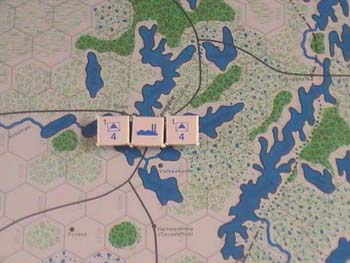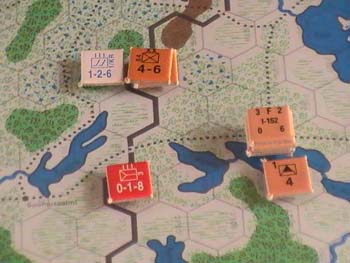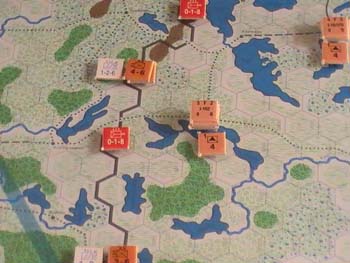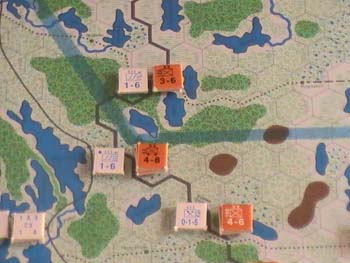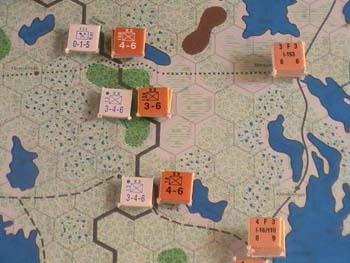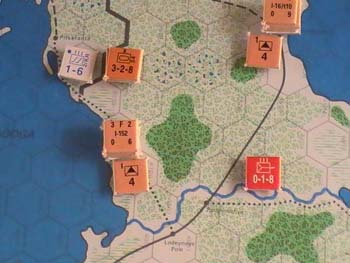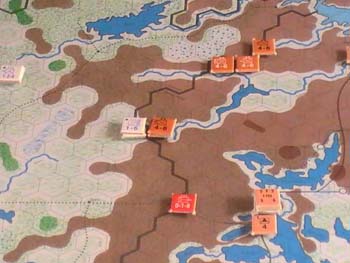D.
Airborne Operations.
If this rule is used, all 1-2-8 parachute-infantry
brigades in the Soviet OB appear as 1-2-5 parachute brigades instead.
The air
drop mission (Rule 20E2) is used to transport and drop parachute units on a target
hex. For the purposes of the air drop mission a transport may carry 1/2 RE of
parachute units. Thus, two transports are required to carry a 1 RE parachute unit
on an air drop.
1. Disruption. A parachute unit may suffer disruption
when making an air drop. During the mission resolution step, roll one die for
each parachute unit making an air drop. Modify the die roll as follows:
-1
for dropping onto enemy units and/or into enemy ZOCs.
-1 for dropping into
a non-clear terrain hex.
-1 for dropping into a major city hex. (This is in
addition to the non-clear terrain modifier.)
-1 for every five hexes (or fraction
thereof) a Soviet air unit flies its cargo to the target hex.
-1 for a drop
during poor weather, which prevails on every turn of the game.
If the modified
disruption die roll is: 2 or greater, the unit is not disrupted. 1 or 0, the unit
is disrupted and has its attack and defense strengths halved. -1 or -2, the unit
has its attack strength reduced to 0, has its defense strength halved, and is
immediately eliminated if in an enemy-occupied hex. -3 or less, the unit is immediately
eliminated.
A parachute unit that becomes disrupted remains disrupted until
the start of its next friendly initial phase. For example, a parachute unit disrupted
during the Soviet air phase would remain disrupted throughout the rest of the
Soviet player turn and
throughout the entire following Finnish player turn.
The disruption die roll is also used for each air dropped supply point. If the
roll is 1 or less, the supply point has been scattered and is eliminated.
2.
Ground Operations. A parachute unit does not gain full ownership of the hex
it occupies during the player turn it makes the airdrop and during the following
enemy player turn. If the hex is not occupied by enemy units, then undisrupted
parachute units gain immediate ownership of any airbase in the hex. For all other
cases and purposes, the parachute units do not gain ownership of the hex. For
example, a supply line may be traced through a friendly-owned hex occupied by
an enemy parachute unit.
Parachute units that jump in hexes other than enemy-occupied
hexes may attack adjacent enemy units per the standard combat rules. They may
attack in conjunction with other friendly units.
Parachute units that jump
in enemy-occupied hexes must attack the enemy units in the hex during the combat
phase. Adjacent friendly units may join in the attack.
When differing sides
occupy the same hex, resolve combat as normal, except that AS (attacker stopped)
results are modified. If an AS is rolled, parachute units which dropped in the
enemy-occupied hex treat the result as an AR (attacker retreat) and must retreat.
All other units treat the result as an AS.
Retreating units are subject
to the effects of all ZOCs they enter, including the ZOCs of enemy units in the
hex from which they retreat. Example: A parachute brigade drops in a hex occupied
by an enemy division. During the combat phase, the parachute brigade must attack,
and the combat result requires it to retreat. Since any hex it can enter is in
the ZOC of the division in the landing hex, the parachute brigade is eliminated.
3.
Planning and Preparation. Airborne operations involving parachute units (but
not supply points) must be planned in advance. The Soviet player must determine
the target hex and the unit to be dropped there one turn in advance of the drop.
·
During his initial phase of the game turn prior to an operation, the Soviet player
writes down the identity of the unit involved in the operation and the target
hex or holding box of the operation. He may plan only one operation at a time
per parachute unit. Once planned, he may cancel an operation in his next initial
phase and plan a new operation for the unit at that time. He may also cancel an
operation during the phase in which it is tooccur.
· During the
initial phase, a player may not plan an operation for a unit that is in an enemy
ZOC at that time. Once planned, the operation must be canceled if the unit enters
an enemy ZOC, attacks, or is attacked at any time from the planning of the operation
to its execution. If for any reason the unit is not able to participate in the
operation during the phase in which it is to take place, the operation must be
cancelled. A player may plan an operation for a reinforcement parachute unit during
the initial phase of the game turn prior to its arrival in the game, so that it
may execute the operation on its turn of arrival.
4. Surprise. Due
to the immense surprise effects airborne operations achieved during this period
of the war, parachute units are treated as being supported on the player turn
they make air drops.
5. Aland Islands. Note that Soviet parachute
units may drop on the Aland Islands Holding Box, which for combat purposes is
treated as a single clear terrain hex. If the Soviet player captures the holding
box, he receives VPs for capturing the point city of Marienhamn.
E.
Variable Game Length.
The rules assume the game will end with the historical
onset of the spring rains in mid-March 1940. The rains could have been delayed,
however, allowing for an extended campaign.
At the end of the Mar 140 turn,
the Finnish player rolls one die. On a roll of 1 or 2 the game ends. On a roll
of 3 through 6 the game continues with the Mar II 40 turn.
At the end of the
Mar II 40 turn, the Finnish player rolls the die again. On a roll of 1 through
4 the game ends. On a roll of 5 or 6 the game continues with the Apr 140 turn.
If
the game continues with the Apr 140 turn, it automatically ends at the end of
that turn.
F. Accelerated Foreign Aid to Finland.
Many European
countries initially were hesitant to come to the aid of Finland. Additionally,
German diplomatic and administrative measures slowed delivery of much of the aid
which was sent. Assuming a more concerted effort to aid Finland is made, the following
rules apply:
· The headquarters of the Finnish 21st, 22nd, and 23rd
Rifle Divisions and the RaskT Artillery Battalion arrive two turns earlier than
specified in the Finnish OB.
· The conversion of the Finnish armor battalion
occurs two turns earlier than specified in the Finnish OB.
· All Finnish
foreign aid reinforcements arrive two turns earlier than specified in the Finnish
OB.
· Finnish foreign aid reinforcements arriving via sea are never
delayed.
· Western intervention is triggered on a roll of 2 or 3 (see
Rule 31A).
For the purposes of game balance, the Finnish player has 10 victory
points deducted from his total if this option is used. (The historical outcome
of the game, but not the player victory, is determined without deducting these
points.)
G. Increased Soviet Preparedness.
The Soviets were
not as prepared for operations in Finland as they thought they were. While many
of the Soviet shortcomings could not be mitigated-or even recognized-before the
war began, some measures could have been taken to improve preparedness had the
Soviets acted to do so. Assuming increased Soviet preparedness, the following
rules apply:
· The Soviet rail capacity is raised to 30 REs.
·
Optional Rules 36C1 and 36D apply.
· All units specified in the Soviet
OB as Dec 139 and Dec II 39 reinforcements are initial units instead. These units
may be added to the forces of any Soviet armies and groups. Additionally, perform
the conversion specified on the Dec II 39 turn.
· Soviet parachute units
may deploy at any airbases in the Soviet Union. The Soviet player may plan air
drops for these units to take place on the Dec 139 game turn.
· All
reinforcements and conversions appear two turns earlier than specified in the
Soviet OB. Note: The flipping of corps headquarters to their regular stacking
sides remains as specified in the order of battle.
For the purposes of game
balance, the Soviet player has 20 victory points deducted from his total if this
option is used. (The historical outcome of the game, but not the player victory,
is determined without deducting these points.)
H. Earlier Start to Campaign.
The
campaign could have started two weeks earlier with the onset of the fall freeze-up.
The following rules explore this possibility.
· The game begins with
the Soviet initial phase of the Nov II 39 game turn.
· The Soviet player
must remove 10 REs from his on-map initial forces and place them in the Strategic
Reserve Holding Box. At least 6 REs of these units must come from 8th and 9th
Armies. These units are released from the strategic reserve on the Soviet Nov
II 39 player turn.
· The rail lines in hexes 35:2107 and 35:3106 are
under construction, and are not completed until the Soviet initial phase of the
Dec 139 turn. Until completion, the rail lines in these hexes are treated as roads.
·
The breakdown regiments of the Finnish "A" Division are deleted from
the Finnish initial forces and appear as Nov It 39 reinforcements.
·
The fort in hex 35:4616 is under construction, and does not complete until the
initial phase of the Finnish Nov 11 39 player turn.
For the purposes of game
balance, the Soviet player has 20 victory points deducted from his total if this
option is used. (The historical outcome of the game, but not the player victory,
is determined without deducting these points.)
Designer's Choice Rules
The
following optional rules are "Designer's Choice" rules. These rules
allow the designer and developers of A Winter War to exercise the full scope of
their creativity, at the cost of greater complexity and somewhat longer playing
time. Use any or all of these rules only by agreement of both players. Since some
of the rules favor one side more than the other, players should decide which "Designer's
Choice" rules they will use before choosing sides.
A. Special Unit
Abilities.
1. Heavy Tanks. The Soviet 35th and 40th Tank Brigades
(3-2-6) are heavy tanks. Heavy tanks may not move or attack across frozen lake
hexsides.
2. Finnish Ski Units. A Finnish ski unit may move in the exploitation
phase, provided it does not move more than half its movement allowance in the
movement phase. Its movement allowance in the exploitation phase is half the unit's
movement allowance in the movement phase. For example, a Finnish 1-8 ski regiment
moving in the exploitation phase has a movement allowance of 4 MPs if supplied,
and 2 MPs if unsupplied.
The procedure is as follows: When a Finnish ski unit
moves in the movement phase of a Finnish player turn, place a light gold-brown
hit marker on the unit if it moves more than half its movement allowance in the
phase. For example, mark a supplied Finnish 1-8 ski regiment if it uses more than
4 MPs in the movement phase. A Finnish ski unit so marked may not move in the
exploitation phase. All unmarked Finnish ski units may move in the exploitation
phase, as described above.
B. Variable Demolition Costs.
Rule
7A3 (Rail Breaks) and 17D (Airbase Damage), and Rule 2983 (Ports) assign a flat
MP cost per unit to damage these types of facilities. When using variable demolition
costs, the MP cost is based on unit size instead.
The Demolition Summary Table
lists the number of MPs each size unit must spend to inflict one hit of damage
on each type of facility. Additionally, engineer-category units are counted at
double their RE size for purposes of this rule. For example, normally a regiment
(1 RE) would spend 3 MPs to break a rail line, yet an engineer regiment would
need to spend only 1 MP to do so, the same MP cost normally required of a 2+ RE
unit.
C. Resolute Western Intervention.
The Western intervention
rule (Rule 31) shows the historically low chances of Western intervention and
the high chances of Norwegian and Swedish resistance to intervention. This optional
rule explores the possibility that the Western powers were more resolute in their
intention to intervene and that Norway and Sweden would be more likely to acquiesce
to the intervention. In this case, modify Rule 31 as follows:
- Western intervention
is triggered on a roll of 4 or less.
- Modify the intervention triggering dice
roll by -1 for each turn after the first turn (Dec 139). For example, modify the
roll by -1 on the second turn (Dec II 39) and by -3 on the fourth turn (Jan II
40).
- Norway resists Western intervention on a roll of 1. On a roll of 2 through
6 it does not.
- Sweden resists Western intervention on a roll of 1 or 2. On
a roll of 3 through 6 it does not. (Modify the roll by -1, per Rule 31 B, if Norway
resists Western intervention.) |
